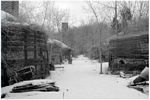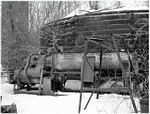|
Redfield Bridge & Tile Works Society for Industrial Archeology Newsletter, Vol.30, Nos. 3-4, 2001 History and Preservation Potential Redfield, Iowa, has been known for high-quality brick and tile production since the 1870s. In 1894, a large and well-financed firm, the Goodwin & Myers Brick & Tile Co., began operations. Unlike many other small brick-making businesses, this company had the financial resources to open big open-pit shale deposits, ensuring its long-term viability. By 1901, Robert Goodwin assumed full control over the plant. The name was changed to Redfield Bridge & Tile Works. The operation's heart was the varied shale deposits left behind by the retreating Wisconsin glacier. These deposits are characterized by a plastic aluminum silicate that is mixed with iron. Consequently, the natural fire clay in the deposit made the bricks very stable during the processing period. The iron in the material turns a rich red when fired, earning the bricks the name "Redfield Reds." Click on photos for larger size Kilns at the Redfield Brickyard A pug mill sits abandoned in the
weeds at the Redfield brickyard. During the company's early years, production was small. As the plant enlarged, sales were made over a wider area. Robert Goodwin's son, Robert, Jr., became good friends with Father Flanagan of Boys Town; consequently Redfield bricks were used in many of the Boys Town buildings. The Garst & Thomas Pioneer Seed Corn Plant in Coon Rapids, IA, and many of the buildings at Iowa State Univ. in Ames are of Redfield face tile. Four generations of Goodwin's took turns operating the Redfield plant and operations were expanded steadily over the years. A 1908 fire destroyed the No. 1 building, and newspapers reported over $20,000 damage to buildings, equipment and materials. Rebuilding took six months. In the early days, the plant operated only six months of each year. During the winter, employees worked at the local ice house. In 1940, the operation became year around, greatly increasing job stability. By 1960, there were up to 60 employees. The first kilns (pronounced 'kills') were down-draft or beehive type. Brick was produced by the soft-mud or molding method, later replaced by extrusion, a more efficient method. Millions of drain tiles were produced at the plant for draining Iowa fields. Some tiles were as large as 36-in diameter, but most were 4- to 12-in. In 1968, a modern drain-tile plant was constructed, featuring a continuous tunnel kiln. Two years later, a second tunnel kiln for brick production was added. Both of these plants were designed by ceramic engineer Wayne Barrett. The old beehive kilns were gradually phased out until production completely stopped in the early 1970s. The Goodwin family sold their interest in the firm to Can-Tex industries in 1970. Can-Tex sold out in 1982 to the current owners, Midland Brick Co. Today, the old brickyard sits empty but not forgotten. Preservationists have been excited by the potential to make it an industrial history site. The current owner is threatening to bulldoze the 40-acre site for scrap metal but is willing to sell the property. State preservation groups are looking into a variety of possibilities to save the site and would welcome any suggestions or assistance with this special project. For more information please contact the following:Pete Malmberg |
Return to Townships | Return to Dallas County IAGenWeb
Copyright © IAGenWeb. All rights reserved.

